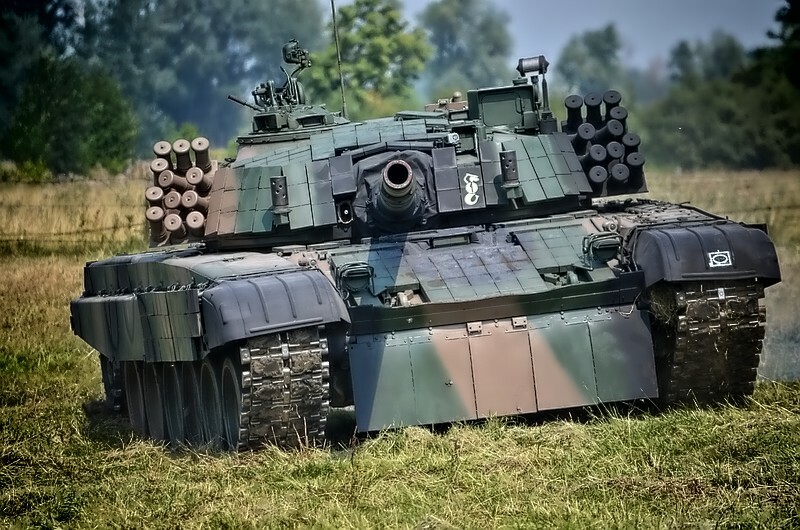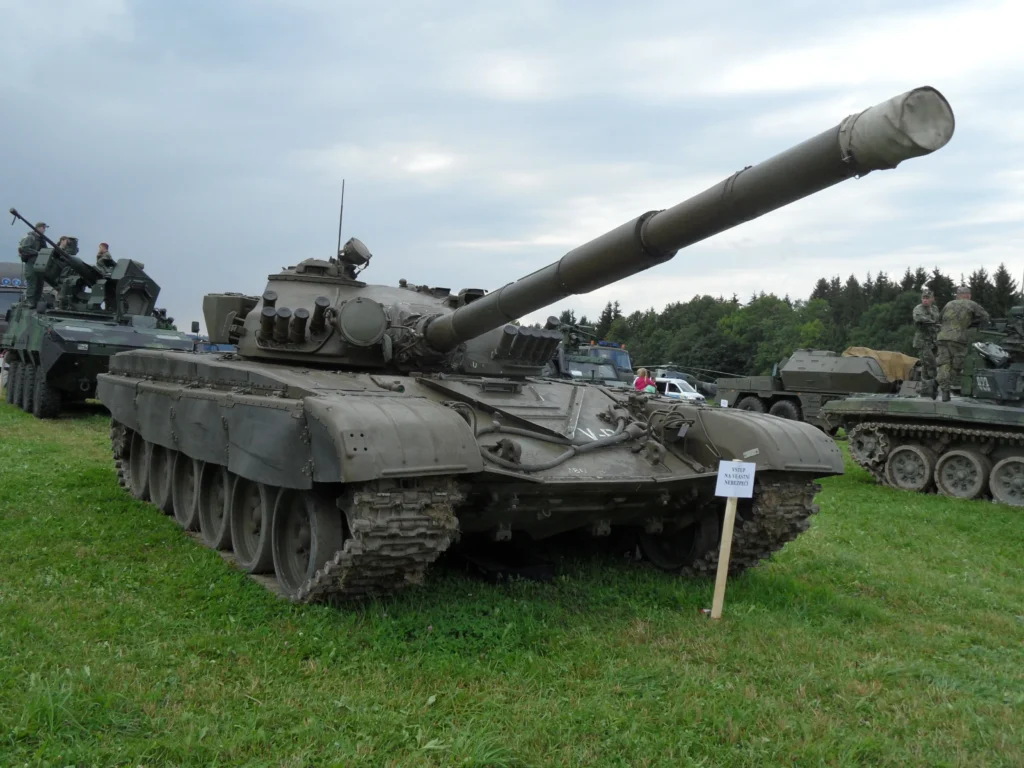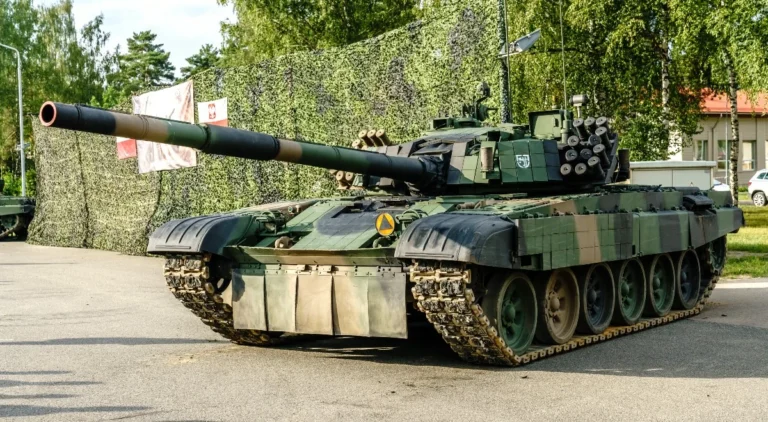The PT-91 Twardy and T-72 are main battle tanks, the former originating from Poland and the latter from the Soviet Union, now Russia. Developed as an evolution of the T-72, the PT-91 incorporates more modern technology and enhancements. Both tanks feature 125mm smoothbore guns capable of firing various ammunition types, along with secondary machine guns for anti-infantry and anti-aircraft purposes. They utilize composite armor for protection, though specifics can vary depending on model versions and upgrades. Powered by V12 diesel engines, both tanks offer similar mobility on the battlefield. However, the PT-91 generally integrates more advanced electronics, including fire control systems and night vision equipment, compared to earlier T-72 variants.
The PT-91 Twardy and the T-72 are both Soviet-era tanks, but the PT-91 is a Polish modernization of the T-72.
PT-91
Incorporation of More Advanced Technology and Upgrades

The PT-91 Twardy is a Polish adaptation and modernization of the Soviet T-72 tank. It integrates several advancements, such as improved targeting systems, enhanced fire control mechanisms, and upgraded ballistic computers.
These technological enhancements contribute to improved accuracy in firing, better target acquisition, and increased effectiveness against modern threats on the battlefield.
Evolution in Armor Composition and Protection
Compared to its predecessor, the PT-91 boasts enhanced armor composition. It incorporates composite materials that provide better protection against various types of ammunition, including kinetic penetrators and shaped charges.
The improved armor design aims to increase survivability and mitigate damage from enemy fire, offering a higher level of protection to the crew and critical components within the tank.
Integration of Modern Electronics and Fire Control Systems
The PT-91 is equipped with modern electronic systems and fire control mechanisms. These include advanced sensors for improved situational awareness, thermal imaging for night operations, and more sophisticated communication systems.
Additionally, its fire control systems enable quicker target acquisition and engagement, enhancing the tank’s overall combat capabilities.
T-72
Original Design Features and Characteristics
The T-72, originating from the Soviet Union, was introduced as a robust and cost-effective main battle tank. Its original design emphasized a balance between firepower, protection, and mobility. Initially, it featured composite armor and a 125mm smoothbore gun, establishing it as a versatile and formidable asset on the battlefield.
Varied Upgrades and Modifications Over Different Versions
Throughout its service life, the T-72 has undergone numerous upgrades and modifications. These improvements addressed shortcomings in the tank’s original design and technology, focusing on enhancing its combat capabilities.
Upgrades included improvements in armor composition, the integration of more advanced fire control systems, and the addition of reactive armor to counter modern threats.
Differences and Similarities in Armor, Armament, and Electronics
While the T-72 shares certain characteristics with the PT-91, such as a 125mm main gun and secondary armaments, differences arise in the specifics of armor protection and electronic systems.
Earlier versions of the T-72 may lack the sophisticated electronic and fire control systems found in the PT-91, but upgraded variants bridge this technological gap to some extent
What are the armament and armor differences between PT-91 and T-72?
The PT-91 Twardy and the T-72 differ significantly in terms of armament and armor.
Similarities in Armament
125mm Smoothbore Guns
Both the PT-91 Twardy and the T-72 are armed with powerful 125mm smoothbore guns, a standard caliber for main battle tanks. These guns are capable of firing a variety of ammunition types, including armor-piercing fin-stabilized discarding sabot (APFSDS), high-explosive anti-tank (HEAT), and high-explosive fragmentation (HE-FRAG) rounds. The 125mm smoothbore guns provide formidable firepower and are effective against armored targets at considerable distances.
Secondary Machine Guns
Both tanks are equipped with secondary machine guns serving dual purposes: anti-infantry and anti-aircraft defense. These secondary weapons, typically 7.62mm or 12.7mm machine guns, allow the tanks to engage infantry units and light armored vehicles effectively. Moreover, they serve as anti-aircraft weapons to counter low-flying threats, offering increased versatility and defense capabilities in various combat scenarios.
Differences in Protection:
Comparative Analysis of Composite Armor:
The PT-91 and T-72 employ composite armor designs, but their specific compositions and protective capabilities may differ. The PT-91’s composite armor is a result of advancements and modernizations, potentially offering enhanced protection compared to earlier variants of the T-72. The composition, arrangement, and materials used in the armor layers could vary, influencing their ability to withstand various types of ammunition and threats.
Specifics Regarding Protection Levels Against Various Threats
The protection levels of the PT-91 and T-72 against different threats, including kinetic energy penetrators, high-explosive anti-tank (HEAT) rounds, and artillery shell fragments, can vary based on the specific configuration and upgrades.
While both tanks utilize composite armor, the PT-91 may incorporate more modern materials and design improvements that offer increased resistance against modern anti-tank munitions, providing potentially higher protection levels compared to certain versions of the T-72.
How do PT-91 and T-72 compare in engine power and battlefield mobility?

While both tanks had decent battlefield mobility, the PT-91 Twardy had an advantage in this aspect due to its more powerful engine, which resulted in improved acceleration, higher top speeds, and better overall performance across different terrains compared to the original T-72.
Engine Specifications
PT-91! V12 Diesel Engine
The PT-91 Twardy is equipped with a powerful V12 diesel engine, specifically designed to provide the tank with adequate power and mobility on the battlefield. This engine configuration ensures efficient fuel consumption while delivering substantial torque and horsepower, essential for maneuverability and operational performance.
T-72! Similar V12 Diesel Engine
The T-72, similar to the PT-91, is also powered by a V12 diesel engine. Over the various versions and upgrades, different models of the T-72 may have seen modifications or enhancements in their engine systems to improve efficiency, reliability, or performance, though fundamentally maintaining the V12 diesel engine configuration.
Comparative Analysis of Mobility
Both the PT-91 and the T-72 exhibit similar levels of maneuverability and performance on the battlefield due to their comparable engine configurations and overall design philosophies.
Their V12 diesel engines provide sufficient power-to-weight ratios, enabling them to traverse diverse terrains, including rough terrain, urban landscapes, and varying climatic conditions.
These tanks’ mobility features, such as suspension systems, track designs, and engine power, allow for adequate speed, agility, and cross-country maneuvering capabilities.
Additionally, their mobility contributes to their effectiveness in tactical operations, facilitating rapid repositioning, flanking maneuvers, and engaging targets while on the move.
FAQ’s
Is T-64 better than T-72?
The T-64 incorporated advanced features ahead of its time, like a more sophisticated autoloader and composite armor, making it technically superior in some aspects compared to early versions of the T-72.
Is the T-90 an upgraded T-72?
The T-90 is an evolved tank that shares design elements with the T-72 but includes significant improvements in armament, armor, and technology, making it more advanced than earlier T-72 variants.
Is T-80 better than T-72?
The T-80 showcased superior speed and mobility due to its gas turbine engine but had drawbacks in certain terrains. Its overall superiority over the T-72 depends on specific operational requirements.
Was the T-72 a good tank?
The T-72 proved to be a widely produced and versatile tank, effective in various conflicts. However, its design had some vulnerabilities compared to contemporaneous Western tanks.
Does Russia use T-72?
Yes, Russia has used and continues to utilize various versions of the T-72 in its armored divisions. However, many have been modernized to improve their capabilities.
Is T-44-100 better than T-54?
The T-44-100, being a post-World War II design, integrated improvements in mobility, armament, and armor compared to the earlier T-54, offering enhanced performance in some aspects.
Final Words
In the end, the PT-91 and T-72 tanks are alike in some ways, such as their big guns and engines that help them move. But the PT-91 has newer stuff like better technology and stronger armor, making it more advanced.
The T-72 has changed a lot over time, but older versions might not have all the cool things the PT-91 has. Both tanks can move around well on the battlefield, but the upgrades they got decide how good they are in different situations. Each tank has its own strengths that make them useful in battles today.

